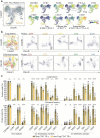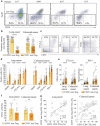Bystander CD4+ T cells infiltrate human tumors and are phenotypically distinct
- PMID: 36524209
- PMCID: PMC9746624
- DOI: 10.1080/2162402X.2021.2012961
Bystander CD4+ T cells infiltrate human tumors and are phenotypically distinct
Abstract
Tumor-specific T cells likely underpin effective immune checkpoint-blockade therapies. Yet, most studies focus on Treg cells and CD8+ tumor-infiltrating lymphocytes (TILs). Here, we study CD4+ TILs in human lung and colorectal cancers and observe that non-Treg CD4+ TILs average more than 70% of total CD4+ TILs in both cancer types. Leveraging high dimensional analyses including mass cytometry, we reveal that CD4+ TILs are phenotypically heterogeneous, within each tumor and across patients. Consistently, we find different subsets of CD4+ TILs showing characteristics of effectors, tissue resident memory (Trm) or exhausted cells (expressing PD-1, CTLA-4 and CD39). In both cancer types, the frequencies of CD39- non-Treg CD4+ TILs strongly correlate with frequencies of CD39- CD8+ TILs, which we and others have previously shown to be enriched for cells specific for cancer-unrelated antigens (bystanders). Ex-vivo, we demonstrate that CD39- CD4+ TILs can be specific for cancer-unrelated antigens, such as HCMV epitopes. Overall, our findings highlight that CD4+ TILs can also recognize cancer-unrelated antigens and suggest measuring CD39 expression as a straightforward way to quantify or isolate bystander CD4+ T cells.
Keywords: CD39; CD4; CD8; HCMV; TIL; bystander; cancer; infiltrating; tumor.
© 2022 The Author(s). Published with license by Taylor & Francis Group, LLC.
Conflict of interest statement
E.W.N is a co-founder, advisor and shareholder of ImmunoScape Pte. Ltd. E.W.N. is an advisor for Neogene Therapeutics and Nanostring Technologies. All other authors declare no potential conflicts of interest.
Figures




References
-
- Dunn GP, Bruce AT, Ikeda H, Old LJ, Schreiber RD.. Cancer immunoediting: from immunosurveillance to tumor escape. Nat Immunol. 2002;3: pp. 991–11. - PubMed
-
- Schreiber RD, Old LJ, Smyth MJ.. Cancer immunoediting: integrating immunity’s roles in cancer suppression and promotion. Science. 2011;331: pp. 1565–1570. - PubMed
Publication types
MeSH terms
LinkOut - more resources
Full Text Sources
Medical
Research Materials
